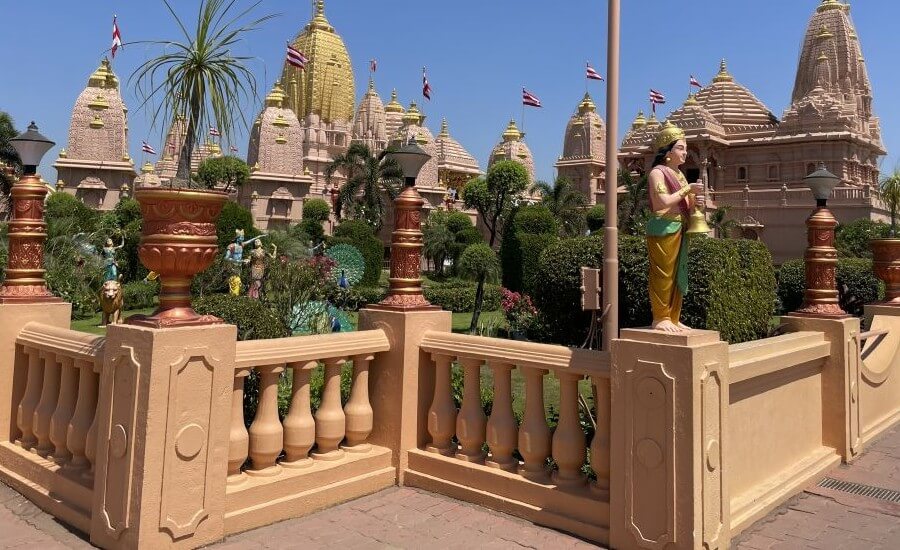
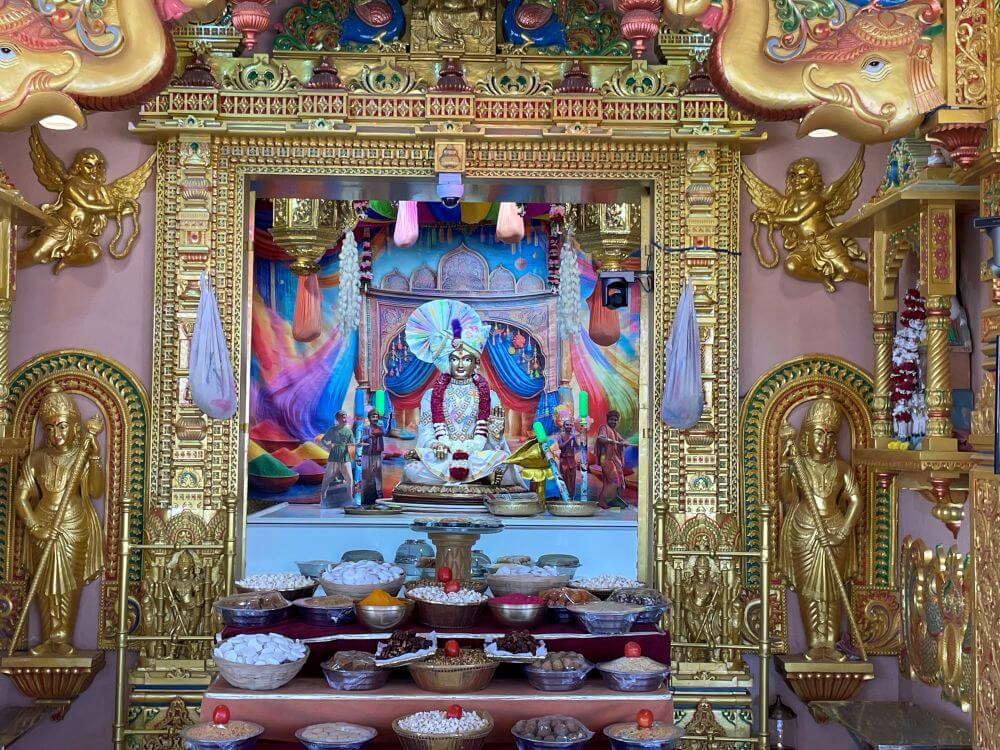
Neelkanth Dham Swaminarayan Temple, dedicated to Lord Swaminarayan, is situated on the banks of the Narmada River, spread across approximately 105 acres and has become a significant attraction for numerous devotees and tourists. The temple beautifully blends architecture, aesthetics and spirituality. The temple premises resemble a palace, featuring gardens illustrating mythological tales and equipped with state-of-the-art facilities. Thousands of visitors from India and abroad visit daily. The temple’s main attraction is the majestic 152-foot-tall statue of Swaminarayan.
Swaminarayan is a renowned religious sect in India founded by Swami Sahajanand, who was born near Ayodhya at Chhapaiya village in 1781.  His original name was Ghanshyam Pandey. He performed intense austerities in the Himalayas, during which period he was known as Neelkanth Varni, giving this temple its name—Neelkanth Dham. He arrived in Saurashtra in 1800 and was initiated into the Ramanandi sect by Guru Ramanand, who renamed him Sahajanand. He traveled widely, spreading the Swaminarayan mantra among devotees. People believe Sahajanand Swami (Swaminarayan) to be an incarnation of God.
His original name was Ghanshyam Pandey. He performed intense austerities in the Himalayas, during which period he was known as Neelkanth Varni, giving this temple its name—Neelkanth Dham. He arrived in Saurashtra in 1800 and was initiated into the Ramanandi sect by Guru Ramanand, who renamed him Sahajanand. He traveled widely, spreading the Swaminarayan mantra among devotees. People believe Sahajanand Swami (Swaminarayan) to be an incarnation of God.
The Rajkot Swaminarayan Gurukul Trust constructed this temple in 2013. Built entirely from solid stone following ancient architectural principles, the temple involved the skilled efforts of around 11,000 craftsmen. 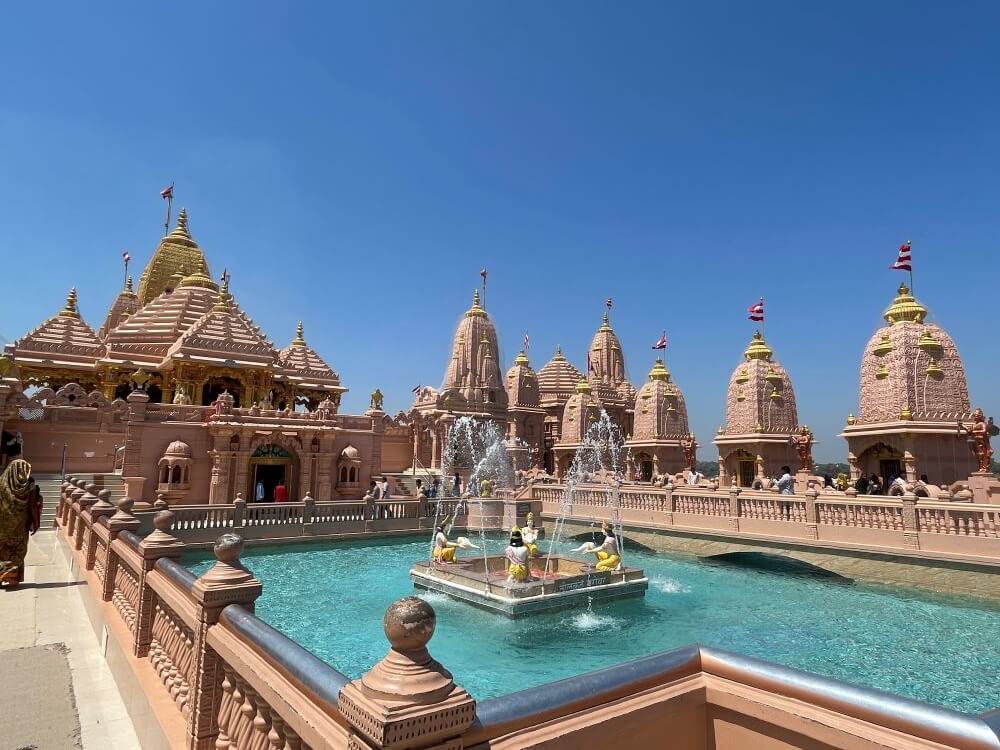 The complex consists of two main parts: Swaminarayan Temple and Sahajanand Universe. The temple has four entry gates and the pilgrimage journey begins from the ‘Manaki’ gate.
The complex consists of two main parts: Swaminarayan Temple and Sahajanand Universe. The temple has four entry gates and the pilgrimage journey begins from the ‘Manaki’ gate.
Visitors experience serenity amid lush greenery while approaching the temple. Sculptures of horses and peacocks adorn the gardens near the entrance. After purchasing an entry ticket, visitors encounter around 20 sculptures of Gajaraj (elephants) in dance poses at the Gajdwar entrance, symbolizing peace and strength. The Gajaraj are depicted holding Lord Swaminarayan seated on a lotus with their trunks. Upon entering through this gateway, a statue of Lord Swaminarayan riding a lion chariot is prominently displayed. The vast courtyard also houses large statues of Lord Ram and Lord Krishna, including Krishna subduing Kaliya.  There is also a garden depicting Krishna’s Raasleela. In this courtyard is ‘Nilkanth Prasadam,’ where devotees can savor various food items. A shopping complex within the premises offers various idols, worship materials, rosaries, and food items for purchase.
There is also a garden depicting Krishna’s Raasleela. In this courtyard is ‘Nilkanth Prasadam,’ where devotees can savor various food items. A shopping complex within the premises offers various idols, worship materials, rosaries, and food items for purchase.
Outside the main entrance called ‘Ghanshyam Dwara’ is a Nataraj fountain featuring a beautiful statue of Lord Shiva performing Tandav dance. The Ghanshyam Dwara has two auxiliary doors adorned with statues of Lord Vishnu. Another entrance called ‘Nilkanth (Nagar Yatra) Dwara’ is situated within the temple complex with two auxiliary doors on either side. The evening procession for Shri Swaminarayan begins from here after performing two circumambulations around the temple followed by grand Aarti.
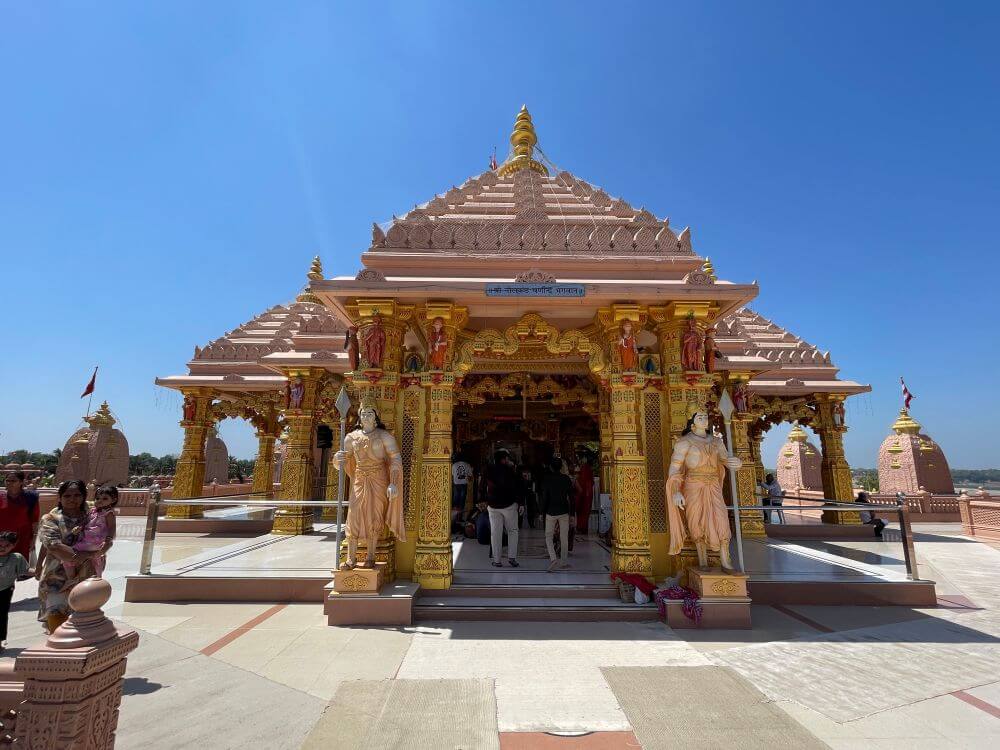 After entering through the Sahajanand Gate here, to the left is the Swaminarayan Mahamantra Jeevan Akhand Dhun Mandir. The continuous chanting emerging from this temple can always be heard throughout the temple premises. A sculpture of Garuda is also present in this courtyard. The elephants at both sides of the steps leading to the main temple welcome devotees. Just a few steps away is ‘Tulsi Kund,’ where devotees light incense sticks.
After entering through the Sahajanand Gate here, to the left is the Swaminarayan Mahamantra Jeevan Akhand Dhun Mandir. The continuous chanting emerging from this temple can always be heard throughout the temple premises. A sculpture of Garuda is also present in this courtyard. The elephants at both sides of the steps leading to the main temple welcome devotees. Just a few steps away is ‘Tulsi Kund,’ where devotees light incense sticks.
To the right of the main temple is the Gomukh Snan entrance. As devotees circumambulate along designated paths, water from 108 Gomukhs falls upon them from Narmada River. The main temple is surrounded by Nilkanth Sarovar and smaller temples nearby. The Nilkanth Sarovar holds 4 million liters of water and features a statue of Narmada Devi within it. 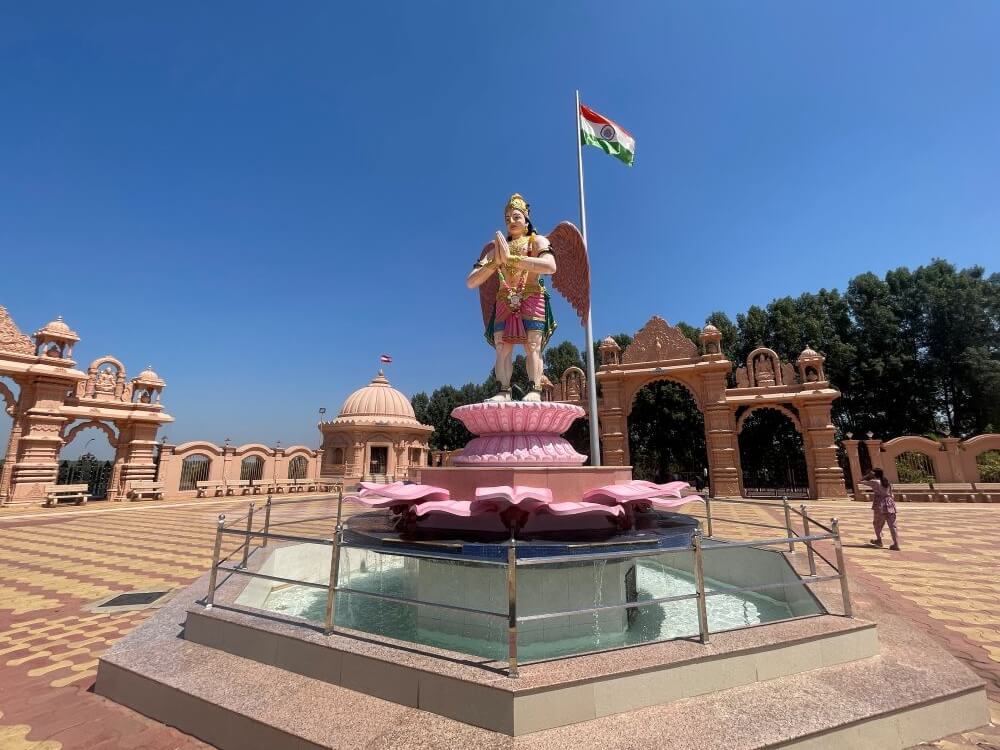 Devotees toss coins here to express their wishes. Statues of deities are carved into shrines along the walls of this sarovar where water flows from Gomukhs.
Devotees toss coins here to express their wishes. Statues of deities are carved into shrines along the walls of this sarovar where water flows from Gomukhs.
Ascending the steps to the main temple reveals a Ganapati temple on the left and a Shiva temple on the right. Flanking both sides of the main entrance to Shri Nilkanth Varni’s temple are door guardians with exquisite carvings on pillars within both open assembly halls and sanctum sanctorum entrances adorned with intricate designs.
The dome-shaped ceiling of the assembly hall showcases sculptures depicting various avatars of Vishnu and scenes from Lord Krishna’s pastimes along with captivating carvings. The entrance to the sanctum sanctorum features beautiful carvings as well as door guardians positioned near plates for prasadam offerings.
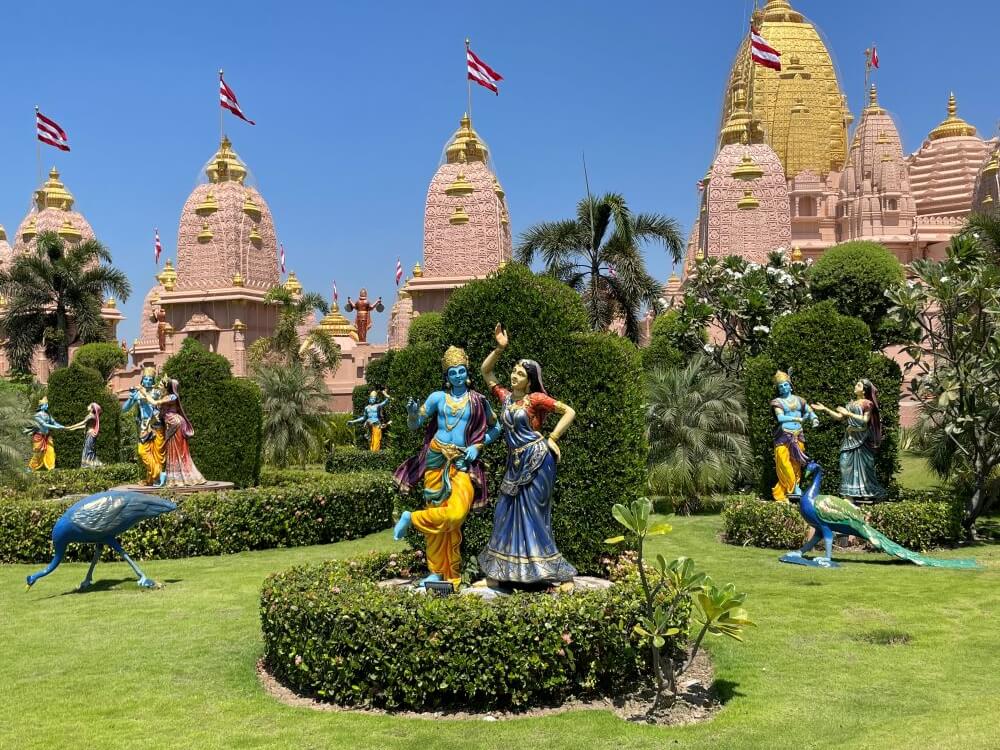 Inside the sanctum sanctorum resides a statue of Shri Nilkanth made from five metals : gold, silver, bronze, copper, and mercury – an exquisite example of sculptural artistry. Unlike other temples that typically feature standing deities, this statue depicts Lord seated on a golden throne allowing devotees to perform Abhishek at his feet. Adjacent to this sanctum are places for Radha-Krishna and Lakshmi-Narayana deities crafted using black and white stones.
Inside the sanctum sanctorum resides a statue of Shri Nilkanth made from five metals : gold, silver, bronze, copper, and mercury – an exquisite example of sculptural artistry. Unlike other temples that typically feature standing deities, this statue depicts Lord seated on a golden throne allowing devotees to perform Abhishek at his feet. Adjacent to this sanctum are places for Radha-Krishna and Lakshmi-Narayana deities crafted using black and white stones.
Another temple dedicated to Bal Ghanshyam features an infant Krishna statue placed in a cradle tied with ropes that devotees can rock back and forth during their visit. This temple holds Aarti twice daily along with Naivedya offered three times throughout the day; decorative clothes and toys adorn Bal Krishna here. 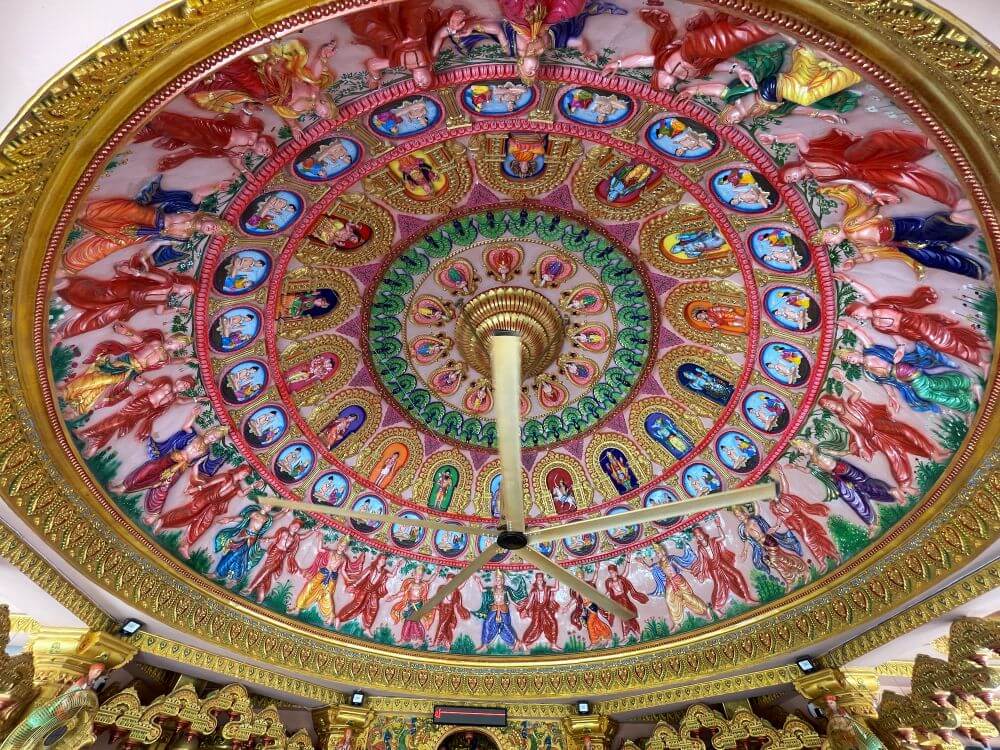 Opposite Bal Ghanshyam Temple lies Ashtabhrajan Hanuman Temple where devotees can perform free oil Abhishek rituals; ‘Sukhadi,’ a sweet dish offered as prasadam is also available here along with daily morning worship rituals including Vaidik ceremonies.
Opposite Bal Ghanshyam Temple lies Ashtabhrajan Hanuman Temple where devotees can perform free oil Abhishek rituals; ‘Sukhadi,’ a sweet dish offered as prasadam is also available here along with daily morning worship rituals including Vaidik ceremonies.
The temple complex includes shrines for various forms such as Hayagriva, Kachchheshvara, Vamaneshvara, Kalki Avatar among others along with Yajna halls for conducting rituals led by Brahmins reciting Vedic hymns. Daily rituals involve offering 108 liters of cow’s milk, herbal waters and colorful powders (Abir-Gulal) to the main idol, followed by Shringar Aarti. The milk from Abhishek is later turned into buttermilk and given as prasadam to tribal children. Food offerings occur nine times daily. At 4 PM, the idol is adorned with a pure gold garment called “Suvarna Angi.” Each evening, a grand procession featuring the idols of Neelkanth and Bal Ghanshyam, along with decorated animals and festive elements, is conducted. A daily boat ride for Neelkanth in the lake is another attraction.
Adjacent to the temple, Sahajanand Universe spans 24 acres, featuring the monumental 152-foot statue of Swaminarayan, built in 2015. Attractions include a birdhouse, aquarium, art gallery, mirror house, science center, light-and-sound shows, 3D films, boat rides, amusement parks and horror shows. A replica of this temple, called “Mini Poicha,” exists in Patdi village, Surendranagar district, Gujarat.
